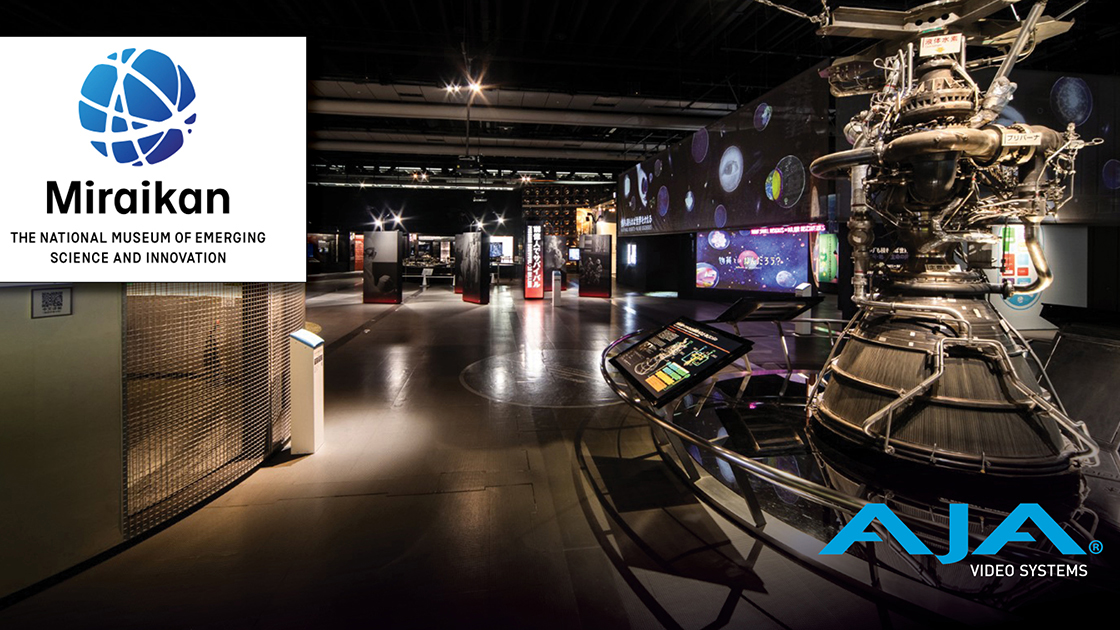Like Earth, museums are in a constant state of change. Attracting new visitors and inspiring repeat visits requires attention-grabbing exhibits and regular updates to existing installations. With this in mind, the Japanese National Museum of Emerging Science and Innovation (Miraikan) in Tokyo launched its spherical earth installation Geo-Cosmos in 2001, which it’s since renovated three times. The latest iteration of Geo-Cosmos elevates the museumgoer experience with 1,500 nit display brightness, exquisite high dynamic range (HDR), wide color gamut (WCG), and high frame rate (HFR) visuals. More than 70 experts through a joint venture from Miraikan, Dentsu, Mitsubishi Electric, GK Tech, and Go and Partners collaborated on the project, which involved the replacement of 10,362 LED display device panels and the development of a new audio, video, graphics, and control system. The team built the solution with AJA technology at its core to ensure rich colors, extended luminance, and smooth video.
The new Geo-Cosmos paints the planet in a more realistic light than previous exhibit iterations, with vibrant imagery and video that instantly capture the attention of patrons. Its goal is to shed light on modern environmental challenges, such as climate change concerns, and help museumgoers better understand their impacts. New to the exhibit are vivid cloud images powered by weather satellite photo data that visualize Earth’s ever-changing appearance. A division of base map background imagery illustrates seasonal color changes, including polar ice and vegetation fluctuations.
[Why Go Wide with dvLED Displays?]
“Geo-Cosmos is a project with purpose and uniquely marries art with science,” shared Go and Partners executive producer and chief technical producer Tsuyoshi Go Hotta. “Between abnormal weather caused by global warming and ecosystem interference, Earth is reaching a breaking point, and the new Geo-Cosmos depicts these changes in a way that’s easy to comprehend. Naturally, we were thrilled to be a part of the initial installation and subsequent upgrades, and our AJA gear proved key in creating a wow effect.”
Miraikan knew the renovation would require a deep understanding of the latest video specifications for content production and systems integration. With a rich technical knowledge base and a team that excels at out-of-the-box thinking, Go and Partners proved a perfect fit for the job. “In talking with the Miraikan team, we knew that conventional SDR technology wouldn’t cut it for a project like this. Accurately depicting the clouds that hover above Earth, the ice fields that blanket the Arctic and Antarctic, and fluctuating cloud luminance would require high dynamic range,” Go Hotta explained. “Yet, working with HDR can be challenging because content often doesn’t look as expected due to differences in creator intent and the production environment. The technology behind it is complex, and very few products perform as we expected, which is why we looked to AJA gear for assistance.”
AJA FS-HDR proved essential in allowing artists to make subtle corrections to the content in the projection environment. The creative team leveraged its fine correction and preset functions to switch out images for content and adjust imagery as needed depending upon ambient brightness variations in the museum environment. “FS-HDR and our other AJA equipment suited our project specifications while also giving us the stability and reliability required for the job, plus the developer SDK is great," Go Hotta added. "It helped save us time.”
An impressive technical feat, the new Geo-Cosmos supports 8K playback of video files output from an 8K recorder/player. Content is produced as OpenEXR still image files in 6,204 x 3,102 resolution, HDR (HLG or PQ), Rec 2020, 59.94 Hz. The system’s HP workstation converts still images into a Geo-Cosmos panel layout with 8K resolution and transforms them into HEVC (H.265) .mp4 8K video. Using computer application software, audio is then added to the HEVC (H.265) .mp4 file, which is transferred to an 8K recorder-player developed with ASTRODESIGN. The sphere plays back the upper half of the 8K image, and two 4K single-link SDI [2 Sample Interleave (2SI)] outputs run through an AJA KUMO 1616-12G router.
The two KUMO outputs are input to two AJA FS-HDR HDR/WCG converters equipped with SFP modules (HDBNC-2TX-12G), which output four Quad Link 3G-SDI signals. The SDI embedded audio signal is output from a separate KUMO channel and sent to a de-multiplexer. The 4K UHD monitors connected to the KUMO are used for video quality control. Eight 3G-SDI signal outputs from the FS-HDRs are converted to fiber, sent into the sphere via optical fiber, and finally displayed on the LED panel.
[SCN Top 50 Systems Integrators 2022]
Geo-Cosmos also supports real-time video playback from external connections, such as a high spec laptop PC. For this use case, an external PC HDMI signal is output in 4K UHD (59.94 Hz or 29.97 Hz) with a 10-bit, 4:2:2, Rec 2020, HDR (display peak brightness 1500 nits), map projection equidistant cylindrical projection. HDMI signals from an external PC are input to an AJA KONA HDMI capture card on an HP workstation, converted to panel placement within the workstation, and output via an AJA KONA 5 I/O card on two 4K SDI (2SI) channels, which are then input to the KUMO.
“The world is rapidly changing, and installations with cutting-edge technology like Geo-Cosmos will soon be commonplace in museums worldwide," Go Hotta concluded. "However, working with these tools to take the museumgoer experience to new heights requires the ultimate agility and flexibility, which AJA solutions provide.”
